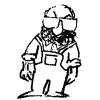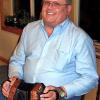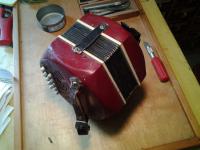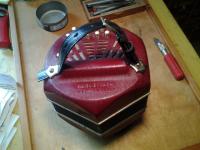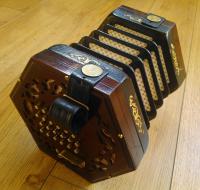Search the Community
Showing results for tags 'history'.
-
I have been reading (and listening) with great pleasure to Dan Worrall's book House Dance. I highly recommend it, both as a wonderful window into concertina history and an education in how to play the Anglo like the real old timers. I am a newbie on the concertina; I don't think I'd even qualify as a toddler, yet. But as someone who has played harmonica for years, and who acquired a melodeon shortly before acquiring an anglo concertina, I began my concertina playing without much in the way of instruction. Since I already understood the structure of the scale and how the buttons worked, I just dove in, transferring some of my harmonica repertoire over to the squeezebox. Rather quickly, and instinctively, I started playing some tunes in octaves -- at first along the row, and then discovering that I could move down to the G row in order to gain notes above A on the left hand. The same trick work on the right hand, too! Eventually, messing around on the web, I found that this octave style was indeed one of the ways folks traditionally approached the instrument, and I discovered Worrall's House Dance, which focuses on just that style of play. Octave playing was once the most common approach to the anglo (or German concertina), used to gain volume and reinforce the beat when a single unamplified concertina might be the only source of music for thirty couples dancing across the dirt floor of a settler's home in South Africa -- or across a wooden platform laid down at some Irish crossroads. I mentioned "listening" to House Dance. The "book" is delivered on CD as a set of well-illustrated web pages and associated audio files. So, as you read about the differences in the octave playing of Scan Tester and William Kimber, you can actually listen to recordings that illustrate the point. The first six chapters of House Dance provide a historical exploration of the concertina's place providing music for dance in the late 1800s and early 1900s in England, Ireland, Australia, and South Africa. The second six chapters look in depth at the playing of traditional concertina artists from each of these countries -- and provide a tutorial in the octave style. The huge number of recordings that accompany the text are a wonderful resource. And these are not recordings that you're going to find on Spotify. (I know; I've looked!) They are from private collections, museums, and other hard to find sources. In addition to music, there are also recordings of interviews with old-time players, talking about the octave style and the house dance context in which it was used. The whole thing is just a flat out marvelous piece of work -- and not just for the historian. There's plenty to learn about playing the anglo in the "pages" of House Dance. I've gone on enough. I ordered my copy of the CD from the Button Box. But there are other places to get it. Worrall's website will point you to the options. All the profits from sale of the book go to the English Folk Dance and Song Society. It's just an excellent piece of work. Dan deserves plenty of thanks for creating it. Happy Squeezing! Greg
- 5 replies
-
- Octave style
- dance
-
(and 2 more)
Tagged with:
-
I came across a rather catchy little tune yesterday Marshall Hilll's Clog. I can't find any 'history' for this tune, though I suspect it's 'Lancashire Clog'. Any ideas? Ta... Later: Oops! I forgot the ABC... MarshallHillsClog.mid MarshallHillClog.pdf MarshallHillClog.abc
- 1 reply
-
- 1
-

-
- provenance
- history
-
(and 1 more)
Tagged with:
-
Although this is primarily accordion focused, the concertina has a brief presence. I've included this video here not so much for its limited concertina content as for the fascinating window it provides into the world of bellows driven free reed instruments and some perspective on their many forms. It's dated 2009, somehow I missed it then but Martin Donohoe of Cavan (Ireland) recently posted a link to it elsewhere that brought it to my attention today. Behind the Bellows
- 2 replies
-
- concertina
- accordion
-
(and 1 more)
Tagged with:
-
Celtic Crossings and Celtic Tours World Vacations proudly present Dr Gearoid’s 2017 Irish History and Heritage Tour August 1-10, 2017 (10 DAYS) ~Living History and Heritage~Music~Archeology~Natural History~Cultural Traditions~ Professor Gearóid Ó hAllmhuráin, born in Ennis, County Clare, is a leading Irish ethnomusicologist, author, musician and historian specialising in Irish music, diaspora, cultural and memory studies. A 5-time All Ireland Champion uilleann piper and concertina player, Gearóid has presented over 1,000 concerts on 4 continents during the past 30 years. A prolific writer and tenured university professor, he is also a producer of The Clare Tracin’ Ensemble and a former member of Ireland’s legendary Kilfenora Céilí Band. CLICK HERE: RESERVATION FORM: Dr Gearoid’s History and Heritage Tour of Ireland Aug 1-10, 2017 Or EMAIL US TODAY! CelticTours World Vacations’ Custom Tour # 89841 Irish History and Heritage Tour Highlights–· Travel with Ireland’s noted cultural historian, author and award-winning traditional musician · Meet locals and enjoy expert-led excursions · Discover spectacular natural beauty · Enjoy nightly musical sessions and private recitals · Explore a living history and heritage of Ireland, dating to the mesolithic period · Immerse yourself in rich culture and heritage · Explore Ireland’s Wild Atlantic Way (Galway, Clare, Limerick, Mayo, Connemara and Kerry) · Enjoy nightly musical sessions and recitals TIME TO EXPLORE· Learn about the extraordinary events of 1916, which placed Ireland on the road to independence from Britain · Stand at the edge of the 702 foot high Cliffs of Moher · Walk around the semi circular stone fort of Dún Aonghasa, on the island of Inis Mór. · Imagine the Irish who lived at the hilltop from c.1500 BC · Visit the castle of the Pirate Queen Grace O’Malley · Spend time in Craggaunowen – a interactive heritage site revealing Irish life in the Iron Age · Engage with ancient Irish archaeology at Caherconnell Stone Fort–which dates to Viking invasions · Encounter dramatic shadows of the Great Famine (1850) –which caused a million deaths and a million to across the ocean MAGNIFICENT NATURAL SCENERY· Experience the breathtaking Burren karst landscape–a cracked lunar bedrock of glacial-era limestone, with cliffs and caves, fossils and rock formations · Ponder the iconic megalithic tomb at Poulnabrone dating from the Neolithic period–one of Ireland’s most photographed archaeological sites · Climb the gravelly incline of Ireland’s sacred mountain, Croagh Patrick, or rest at Teach na Miasa visitor centre to watch others follow in St Patrick’s footsteps · Wind around the Ring of Kerry –beautiful mountains, lakes and hidden vistas · Explore archaeological monuments along the Dingle Peninsula, which National Geographic Traveler once described as “the most beautiful place on earth.” · Behold the 1200-year-old Gallarus Oratory–an early Christian stone church and rare prehistoric Fahan Beehive Huts · Cruise along the majestic River Corrib onto Lough Corrib, the Irish Republic’s largest lake, past castles and various sites of historical and cultural interest ENJOY LOCAL IRISH COMMUNITIES· Learn useful Irish expressions– the oldest spoken language in western Europe · Step out for a traditional dance or try your hand at learning a simple tune on the traditional whistle · Meet members of the Kilfenora Céilí Band–Ireland’s oldest continually surviving dance band · Explore Galway City, European Capital of Culture (2020) · Meet local artists and craft designers · Be welcomed as a royal visitor at Bunratty Castle’s famed medieval banquet and theatrical performance · Visit Claddagh Village–inspiration for the timeless Claddagh Ring · Savor locally sourced cuisine and perhaps try your hand at scavenging for nutritional seaweed · And much more! See the complete itinerary and your reservation form PROFESSIONAL TRAVEL ARRANGEMENTS provided by CelticTours World Vacations (Albany, NY) CLICK HERE FOR RESERVATION FORM CONTACT · Jeanne Orenstein, Celtic TourS (Albany, NY) · 518-862-0042 x310 Email: jeanneo@celtictours.com · EMAIL US TODAY! CelticTours World Vacations’ Custom Tour # 89841 RATES INCLUDE:· 9 nights hotel accommodations · 9 full breakfast daily (except day of arrival) · 4 hotel dinners plus Bunratty Castle Banquet · Admissions: · Cragganowen · Quin Abbey · Bunratty Folk Park · Cliffs of Moher Visitor Centre · Caherconnell Fort & Sheepdog demonstration · Aran Island Ferry and island tour to Dun Aonghasa · Kylemore Abbey (photo stop) · Muckross House · Kilfenora Burren Museum · Lough Corrib Boat Cruise · Galway Walking tour · All transportation and sightseeing via deluxe touring motor coach · Tips and taxes on items included
-
- concertinatravel
- ireland
- (and 7 more)
-
I recently bought a "new" concertina at an antique store to upgrade my existing box. I currently play an economy box from the 50-60's that is a little weazy and cranky. My needs are limited. I play folk songs, Christmas carols and Woodie Guthrie using the hand held harmonica with bass approach. The "new" box has aluminium ends with heavy maroon textured paint. It says "BREVETTATA MADE IN ITALY". It had no straps but I tested it in the store by holding one end between my knees. All the buttons work and the bellows are tight. It has a clean bright sound and seems in tune to my inexpert ears. Here's the problem. The left hand side is upside down ie. the low notes are on top. I thought it might be reversible but upon taking off the end plate there seems no way in and I didn't want to use force and risk breakage. I will mention I've had a few accordions apart and done some repairs. Everything was always self evident. Not so this time. So why was it made this way? Is this a weird variant or was it customized? Someone played it a lot. You can see by the wear on the finish. Thanks in advance for any insight you can give.
-
I'm starting a pinned thread here simply to provide links to some of the images from the old static museum page of a few years ago, as there have been requests. To keep this short enough to browse I'll keep the thread closed and invite discussion, if any, by a regular thread. Scan of a Lachenal label: from a Lachenal English number 60325 (1930s), scanned by spindizzy (Chris) and edited by tallship (Pete). Click for the full file (1300 by 800, about 400 KB as a jpeg). Ken
-
I went camping up the road from where I live at the weekend, and to my delight stumbled across a place called Kettle Bridge. My local concertina group (English) is called Kettle Bridge Concertinas (http://www.kettlebridgeconcertinas.org.uk/) and I oft wondered where the name came from - and now I know Sorry if this doesn't fit in this forum, but I wanted to share my happiness of this discovery, and tell a little part of concertina related history!
-
Hello! I'm a new user on this forum so first off wanted to say hello! I've been playing concertina for about 20 years since the age of about 10! I've just bought a new wooden ended wheatstone concertina - my other concertina is a metal-ended and very loud so wanted something a little quieter for acoustic song accompaniment. However, my new concertina has an interesting history which I'm fascinated by and I would to get to the bottom of it. It has the usual Wheatsone label on one side but a very unusual label on the other side which reads: MADE TO ORDER OF T. WALLACE CHURCH, LANCS. WHEATSTONE & CO. MANUFACTURERS, LONDON. The normal label reads: WHEATSTONE & CO. PATENTEES AND 22551 MANUFACTURERS 20, CONDUIT STREET, LONDON, W I bought the concertina from barleycorn concertinas and have been told that to find a Wheatstone with the name of another person is extremely unusual. I've looked up T Wallace on the 1911 census and found that he was 49, living in Church, Lancashire and is described as a 'dealer and repairer of musical instruments'. However I can find no other trace of him or any connection Wheatstone on the internet. Church in Lancashire is very small place. The population now is under 4000 and it was probably smaller in the 1890's. I just wondered if anyone had come across anything similar or had ever heard of a T Wallace who dealt in concertinas or how he would have managed to get Wheatstone to actually add his name to the label! Thanks so much and I look forward to chatting to you all :-) Louise x
- 18 replies
-
- wheatstone
- concertina
-
(and 3 more)
Tagged with:

